Analysis of hepatitis C virus-inoculated chimpanzees reveals unexpected clinical profiles
- PMID: 9525575
- PMCID: PMC109692
- DOI: 10.1128/JVI.72.4.2589-2599.1998
Analysis of hepatitis C virus-inoculated chimpanzees reveals unexpected clinical profiles
Abstract
The clinical course of hepatitis C virus (HCV) infections in a chimpanzee cohort was examined to better characterize the outcome of this valuable animal model. Results of a cross-sectional study revealed that a low percentage (39%) of HCV-inoculated chimpanzees were viremic based on reverse transcription (RT-PCR) analysis. A correlation was observed between viremia and the presence of anti-HCV antibodies. The pattern of antibodies was dissimilar among viremic chimpanzees and chimpanzees that cleared the virus. Viremic chimpanzees had a higher prevalence of antibody reactivity to NS3, NS4, and NS5. Since an unexpectedly low percentage of chimpanzees were persistently infected with HCV, a longitudinal analysis of the virological profile of a small panel of HCV-infected chimpanzees was performed to determine the kinetics of viral clearance and loss of antibody. This study also revealed that a low percentage (33%) of HCV-inoculated chimpanzees were persistently viremic. Analysis of serial bleeds from six HCV-infected animals revealed four different clinical profiles. Viral clearance with either gradual or rapid loss of anti-HCV antibody was observed in four animals within 5 months postinoculation. A chronic-carrier profile characterized by persistent HCV RNA and anti-HCV antibody was observed in two animals. One of these chimpanzees was RT-PCR positive, antibody negative for 5 years and thus represented a silent carrier. If extrapolated to the human population, these data would imply that a significant percentage of unrecognized HCV infections may occur and that silent carriers may represent potentially infectious blood donors.
Figures
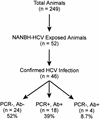
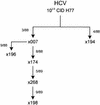
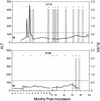
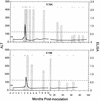
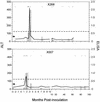
References
-
- Aach R D, Stevens C E, Hollinger F B, Mosley J W, Peterson D A, Taylor P E, Johnson R G, Barbosa L H, Nemo G J. Hepatitis C virus infection in post-transfusion hepatitis. N Engl J Med. 1991;325:1325–1329. - PubMed
-
- Abe K, Inchauspe G, Shikata T, Prince A M. Three different patterns of hepatitis C virus infection in chimpanzees. Hepatology. 1992;15:690–695. - PubMed
-
- Alter H J. To C or not to C: these are the questions. J Am Soc Hematol. 1995;85:1681–1695. - PubMed
-
- Alter H J, Purcell R H, Shih J W, Melpolder J C, Houghton M, Choo Q L, Kuo G. Detection of antibody to hepatitis C virus in prospectively followed transfusion recipients with acute and chronic non-A, non-B hepatitis. N Engl J Med. 1989;321:1494–1500. - PubMed
-
- Alter M J. Epidemiology of hepatitis C in the west. Semin Liver Dis. 1995;15:5–14. - PubMed
Publication types
MeSH terms
Substances
Grants and funding
LinkOut - more resources
Full Text Sources
Other Literature Sources
Medical
Research Materials

